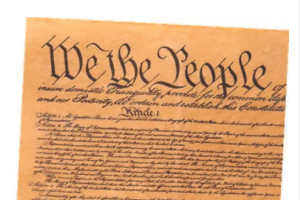CTP—In the hot, humid weather of a Philadelphia summer, delegates wrangled, tempers flared over the one issue they could not resolve—how states should be represented in the national government.
Finally, after delegates from Delaware, New Jersey, and Maryland threatened to return home, Roger Sherman again stood up and again offered his plan—proportional representation in the lower house, equal representation in the senate.
The Connecticut Compromise
The vote on the “Connecticut Compromise,” as it was called, was five to five; nevertheless, it was recorded as passing. Many of the nationalists, including  Madison and Hamilton, still wanted only proportional representation, but the best they could get, they found, was a compromise.
Madison and Hamilton, still wanted only proportional representation, but the best they could get, they found, was a compromise.
The convention adjourned on July 26, leaving a committee to draw up the draft of the new constitution.
The draft, released on August 6, contained the Connecticut Compromise—the lower house, the House of Representatives, would have proportional representation, while the upper house, the Senate, would admit two representatives from each state.
Election of the President
The executive, called the president, would be elected indirectly by the people—that is, the people would vote for electors who, in turn, voted for the president. The number of electors for each state was to be proportional to its population.
This measure, the delegates thought, put a buffer between the people and the president, for each elector had the discretion to vote against the will of the people who chose him. The delegates did not trust the wisdom of the common folk, who, they thought, tended to mobocracy.
Role of the President
The president would be commander-in-chief of the armed forces and would have veto power over congressional legislation.
Only a two-thirds majority in both houses of the legislature could override a president’s veto.
Supreme Court
Finally, the draft established a supreme court whose members, appointed for life by the president with the consent of the Senate, would serve during good behavior.
Lifetime terms, the delegates hoped, would free the court from political pressures, such as the need to curry favor with politicians or with the public in elections.
Further debate of draft of U.S. Constitution
The draft for the constitution, of course, did not end all controversy. 
Delegates debated over immigration, a standing army, paper money, and property qualifications for public office.
The disputes over the perpetuation of the slave trade presaged an important division in the United States in the coming years—the division between North and South.
One prominent southerner and slave owner, George Mason of Virginia, called for an end to the slave trade, but delegates from South Carolina and Georgia objected. General Charles Cotesworth Pinckney of South Carolina protested that the economy of his state needed slave labor, and John Rutledge of South Carolina predicted the secession of three states if the slave trade were not continued.
The convention therefore adopted a compromise that allowed the foreign slave trade for another 20 years, after which time it would be illegal.
Fierce Debate re: Powers of the National Government
Another controversy surrounded the coercive powers of the national government.
Paterson’s New Jersey Plan said that if a state ignored an act of Congress, the president should have the power “to call forth the power of the confederate states . . . to enforce and compel obedience.”
Many delegates, including Madison, objected to this provision, since, they said, it could lead to the forceful domination of the small by the large states.
What the delegates decided is embodied in Article 6 of the U.S. Constitution—the national government could not resort to force but only to the courts of law if states refused to comply with congressional acts.
Result: The Federal model of Government
What resulted from all the debates was a “federal” model of government, that more or less defined the areas where the national and state governments exercised sovereignty.
The United States was to have two sovereigns—the states in regards to their internal affairs, and the national government in relation to national matters, such as war and peace, treaties with foreign nations, and international and interstate trade.
As one aspect of this sovereignty, the national government would have the authority to lay taxes directly on citizens, bypassing state legislatures, and thus freeing it from monetary dependence on the states.
Most of the delegates were dissatisfied when they came to sign the constitution on September 17, 1787.
All of the New York delegates, except Alexander Hamilton, refused to sign—and Hamilton called the document “a weak and worthless fabric.” Luther Martin declared the constitution opposed to liberty, and George Mason refused to sign it, as did Edmund Randolph and Elbridge Gerry.
Daniel Carroll, Charles Carroll’s brother, called the constitution “the Continental Congress in two volumes instead of one,” and Madison declared that “the change which it proposes comes to much less in the addition of New Powers to the Union, than in the invigoration of its Original Powers.”
Many delegates thought the constitutional convention largely a failure.
A different view
Benjamin Franklin, however, held a different view. An eyewitness wrote:
Looking towards the President’s chair at the back of which a rising sun happened to be painted, [Franklin] observed to a few members near him, that painters had found it difficult to distinguish in their art a rising from a setting sun. I have, said he, often and often in the course of the Session, and the vicissitudes of my hopes and fears as to its issue, looked at that behind the President without being able to tell whether it was rising or setting: but now at length I have the happiness to know that it is a rising and not a setting Sun.
RELATED RESOURCES:
- Catholic Textbook Project — beautiful, accurate history textbooks for Catholic schools (and more)\
- Institute for Catholic Liberal Education — exceptional resource for Catholic educators





You must be logged in to post a comment.